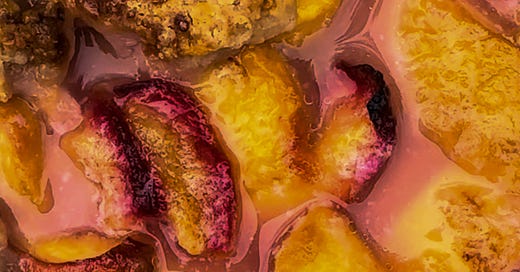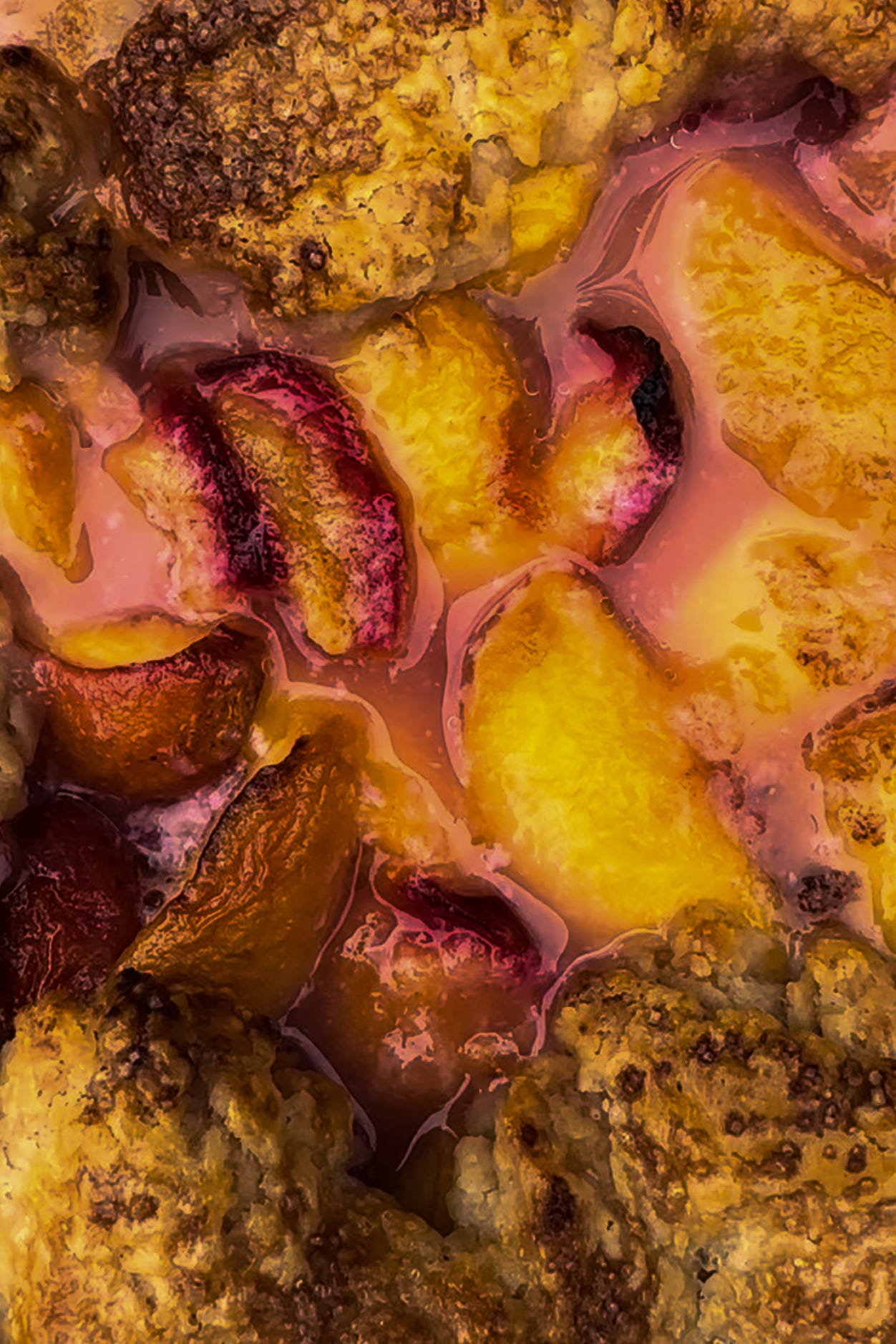
James and I are sitting side by side at the island in the kitchen. I am in my pajamas, my laptop is open on the counter in front of me. I am sipping hot coffee with cream from a big ceramic mug with a handle. James is wearing jeans and a t-shirt, (he always gets dressed as soon as he wakes) his laptop is leaning in its stand in front of him. He is sipping warm black coffee from a small handleless mug. I am reading up on lard and the role it plays in flaky pastries. He is watching a Youtube video on the construction of the ITER Tokamak, a fusion reactor being built in France. This is us - different, but together.
The lard research was sparked by a recipe for a Peach, Nectarine and Lard Pie in Claire Ptak’s latest cookbook Love Is a Pink Cake. I had a few punnets of peaches, nectarines and plums to use up (see last week’s note where the farmer’s market I visited had every fruit and vegetable, all at once) and a tub of lard from the butcher. This pie was the perfect vehicle.
Lard pastry doesn’t sound sexy. It sounds heavy. Vegetable shortening was the norm in households when I was growing up. It was white and odourless, wrapped in parchment and stored in a cardboard box. Our box, until my dad had a heart attack and all fat was banished from the kitchen, lived in the back of the fridge next to an open box of baking soda.
Growing up I knew that shortening made for a flaky crust. I watched the ad with the fork hitting the crust of a cherry pie in slow motion, launching shards of pastry into the air. Lard was used in far away places. The American South. England. When I studied in France and wanted to make an apple pie, I looked for shortening at the grocery store and was scolded by the woman at the till when I told her what I was up to. Use butter! she shouted, aghast. So yes, some use shortening for flakiness, some use butter for flavour, and others use lard. But I had forgotten exactly why the latter was the best.
Butter contains 15-20% water by weight. That water is released when worked into flour and binds with the gluten in the flour. This causes the layers of the dough to stick together. If they’re stuck together they can’t steam apart as they bake and the pastry becomes chewy and elastic. Vegetable shortening and lard don’t have the water content of butter, so there is little to activate gluten when working it with flour. Things stay light and flaky. Vegetable shortening, however, is highly processed and full of trans fats. Lard is full of cholesterol, but has zero trans fats, and has all the beneficial baking qualities of shortening. What it’s missing is the flavour of butter.
In Claire’s recipe for lard pastry she adds this baker's tip: The use of lard in the pastry is what makes it so flaky while keeping a crisp bottom. The butter is there for flavour. If I were not catering to different dietary requests, I would choose this pastry every time for pies, no question.
Well. That was enough for me. Lard for flakiness, butter for flavour and tenderness. They’re different, but better together.
Later I cut the lard and butter into flour with two knives. I’ve never had a pastry blender, the tool you wear like brass knuckles and slice away at the fat and flour. I know this because my Dad used to have a set of brass knuckles that he kept in an old wooden box on his dresser. They came from his grandfather, who used to keep them behind the front desk of his brother’s country inn, ready if a ruckus broke out. I loved peeking inside that box when I was little. I’d visit the small glass jar filled with our baby teeth, his university ring, old coins and a small mechanism for weighing gold dust (also kept behind the desk at the Inn in case a prospector came by). The brass knuckles, curved and hefty in my little hand, lived in this box with all those precious things and stayed there until the box was stolen from my parents home twenty years ago. And now here I am thinking of those things as I cut through the flour. This is what happens when baking. It’s meditative; thoughts become clouds and pass on through.
I pull the dough together and tip it onto the counter, add some water and smear the dough, turn it, and smear it again until it comes together loosely. Shaggy is the word my grandmother would have used. She was from the lard generation. She didn’t go on about emulsification and how activated gluten will make for tough pastry. She didn’t say that the process should be fast so the cold pockets of lard inside the layers of gluten will hold their shape until they hit the hot oven and slowly begin to melt. She didn’t say that those pockets are what creates flakiness. She knew by feel.
I tip a bowlful of peaches, nectarines and plums into the pie plate and flop the edge of the pastry over the filling. It’s a galette of sorts, a pie that’s not too fussy, that doesn’t rely on beauty or skill. Just feel and flavours. Something for him, and for me.
Peach, Plum and Nectarine Lard Pie - adapted from Claire Ptak’s Love Is a Pink Cake
Serves 6-8
1 quantity lard pastry*
2 tbsp cream
2 tbsp demerara sugar, for sprinkling
For the filling,
4 peaches, 2 nectarines, 2 plums (or any combination totalling 1kg / approx
2 lbs stone fruit)
200g (1 cup) white sugar
1 tbsp cornstarch (or 2 tbsp flour)
Pinch of salt
2 tsp vanilla
1 tsp almond extract
60g (¼ cup) butter, cubed
Preheat the oven to 400F / 200C
Butter a 23cm/ 9 inch pie plate. Roll out pastry on a lightly floured surface until it’s large enough to flop generously over the sides of the pie plate. Place the plate, with the pastry flopping over the side, into the refrigerator while you make the filling.
Cut the fruit into eighths and remove the stones. Toss with the sugar, cornstarch (or flour) and salt. Add the vanilla and almond extract and toss again.
Take the chilled pastry in the pan out of the fridge and fill it with the fruit. Dot with the butter. Flop edges of the pastry over the fruit. There will be a hole in the centre where the fruit is visible. Brush the pastry with cream and sprinkle with sugar.
Bake for 45 minutes, or until the fruit is bubbling and the pastry is golden. Allow to sit for at least an hour before serving.
*for the Lard Pastry:
Makes enough for the bottom, or top, of one pie.
280g (2 cups) all purpose flour, plus more for sprinkling over the counter
3/4 tsp sea salt
1 tsp white sugar
150g (2/3cup) very cold, unsalted butter, cubed
55g (1/4 cup) lard
4-6 tbsp ice water
Combine the flour, sea salt and sugar in a bowl. Cut in butter and lard using two knives or a pastry cutter. Spoon in the water, a tbsp at a time, until the flour and fat (sort of) comes together. Tip it out onto a clean countertop and combine it, folding and smearing the mixture, as you go. Add another tbsp of water as needed. Form dough into a ball, flatten it, wrap it and rest it in the refrigerator for an hour, overnight, or freeze it for up to 3 months. In SALT FAT ACID HEAT Samin Nosrat recommends keeping extra pastry in the freezer so when fruit is in season (for peaches, nectarines and plums it seems to happen all on the same day) a regal dinner is always within reach. I love that advice.
Keep reading with a 7-day free trial
Subscribe to Food Stories to keep reading this post and get 7 days of free access to the full post archives.




